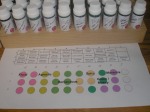So, we have dipped a toe in perfume structure (which is by no means set in stone), but how do we know what kind of fragrance/aroma we like, how do we describe our fragrance choice – what language do we use?
To simplify the world of aromatic materials and the wondrous blends they can create, a classification system was created and most finished perfumes fall into a ‘Fragrance Family’, there are predominantly five main families as follows:
Citrus – Light, refreshing, uplifting, zesty and fruity. Typical notes or ingredients, include: Orange, Grapefruit, Lime, Tangerine, Lemon, Mandarin, Petitgrain
Citrus compositions can also cross over with other categories, to create sub-groups:
- woody citrus, Agarwood, Sandalwood, Fir or Cedar may be added
- chypre citrus, where a more ‘foresty’ note is added with Patchouli, Clary sage, Labdanum, Pine
- Spicy citrus; elements of spice such as Ginger, Pepper, Clove, Anise, Cinnamon are added.
Floral – romantic, feminine, sensual, pretty
Typical ingredients are Rose, Jasmine, Tuberose, Ylang ylang, Lotus, Neroli, Iris, Violet, Gardenia, etc
This is the largest family, easily recognisable and extremely versatile and can be sub-divided into the following divisions:
- Single note (called a Soliflore), evoking the smell of one flower, ie Tuberose or Jasmine, surrounded by supporting notes to enhance facets of the flower, or a
- Floral Bouquet, like dipping your nose into a heavenly bouquet of mixed flowers – 3 or more floral notes, none dominating, to give a harmonious fragrance.
- Green/fougere – floral notes blended with basil, mint, thyme, violet leaf, rosemary, giving the impression of freshness and foliage
- Oriental (Floriental) – heady, with sensuous notes of Vanilla, Frankincense, Clove, Benzoin, Labdanum
Oriental – Usually recognisable by their rich, soft and seductive aroma; tenacious blends with a vanilla structure combined resonant woods and resins, exotic flowers and spices.
Typical natural ingredients may include, Sandalwood, Rosewood/Ho wood, Oud, Cedarwood, Vanilla, Amber, Clove, Nutmeg, Cinnamon, Tuberose, Gardenia, Ylang, Jasmine, Rose Orris, etc, also animal notes (of synthetic origin or naturally created musks), leather and tobacco notes – these are not for the shrinking violet!
Sub-divisions of the Oriental fragrance family include:
- Floral woody – warm, dry, woody and sweet
- Floral spicy – sweet and spicy
- Soft oriental – with a more pronounced powdery base
Some classic examples of that fall under the oriental umbrella are: Opium, Boucheron, Coco, Poison, Boudoir, Obsession and one I vaguely recall my mum using is Cinnabar by Estee Lauder – is this still available?
Chypre – taken from the island of Cyprus – ‘chypre’ in french – the legendary birthplace of Aphrodite, goddess of love and beauty. This family is characterised by ‘foresty’ type scents, usually with a floral and/or citrus component, but drawing on ingredients such as Lavender, Oakmoss, Bergamot, Patchouli, Clary Sage, Vetiver, woods, spices and resins; complex, sophisticated and unisex. There is a warmth and dryness about chypre compositions which personally I find intriguing, sexy and rather elegant.
Like the floral family, chypre’s can also be sub-divided:
- Fruity Chypre
- Floral Chypre
- Fresh or green chypre – more woodland, leafy and freshy and less earthy notes
- Leather Chypre – quite butch, with a smooth leather note
Fougere/Green – Fresh, ferny aromatics, essentially androgynous but very popular with men. ‘Outdoorsy’ in character, fragrances in this group usually comprise of evergreen essences such as Cedarwood, Juniper, Cypress, Galbanum, Clary sage, Lavender and Lime or other citrus to give a more zesty, refreshing note.

